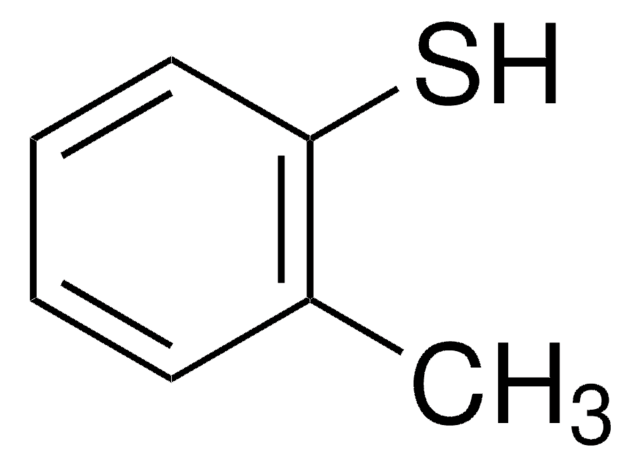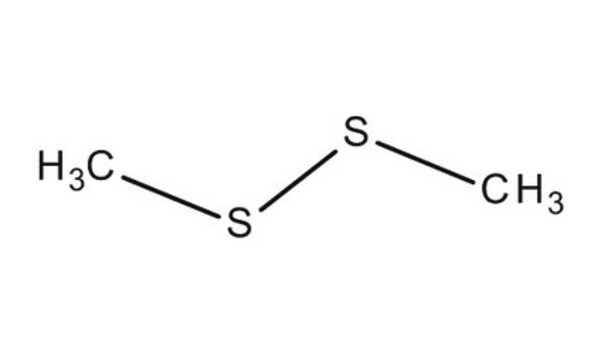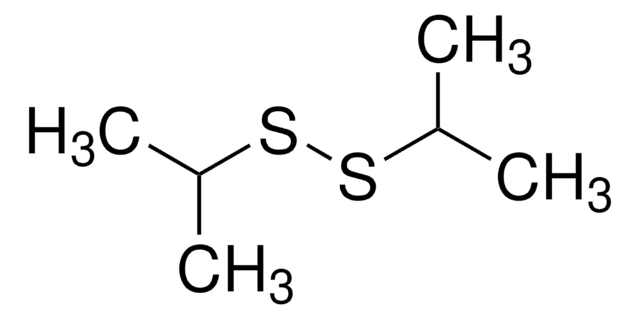Kluczowe dokumenty
W353604
Dimethyl disulfide
≥98%, FG
Synonim(y):
DMDS, Methyl disulfide
About This Item
meets purity specifications of JECFA
Polecane produkty
pochodzenie biologiczne
synthetic
Poziom jakości
klasa czystości
FG
Fragrance grade
Halal
Kosher
agency
follows IFRA guidelines
meets purity specifications of JECFA
zgodność regionalna
EU Regulation 1223/2009
EU Regulation 1334/2008 & 178/2002
FDA 21 CFR 172.515
gęstość pary
3.24 (vs air)
ciśnienie pary
22 mmHg ( 20 °C)
Próba
≥98%
temp. samozapłonu
>572 °F
granice wybuchowości
16 %
współczynnik refrakcji
n20/D 1.525 (lit.)
bp
109 °C (lit.)
mp
−85 °C (lit.)
gęstość
1.046 g/mL at 25 °C (lit.)
Zastosowanie
flavors and fragrances
Dokumentacja
see Safety & Documentation for available documents
alergen pokarmowy
no known allergens
alergen zapachowy
no known allergens
Organoleptyczne
cabbage; onion; vegetable; sulfurous
ciąg SMILES
CSSC
InChI
1S/C2H6S2/c1-3-4-2/h1-2H3
Klucz InChI
WQOXQRCZOLPYPM-UHFFFAOYSA-N
Szukasz podobnych produktów? Odwiedź Przewodnik dotyczący porównywania produktów
Powiązane kategorie
Zastosowanie
- GC-IMS-Based Volatile Characteristic Analysis of Hypsizygus marmoreus Dried by Different Methods.: Dimethyl disulfide is used to enhance the aroma of some fresh seafood to, this shows that it can be used to optimize flavor (Lai et al., 2024).
Hasło ostrzegawcze
Danger
Zwroty wskazujące rodzaj zagrożenia
Zwroty wskazujące środki ostrożności
Klasyfikacja zagrożeń
Acute Tox. 3 Inhalation - Acute Tox. 3 Oral - Aquatic Acute 1 - Aquatic Chronic 1 - Eye Irrit. 2 - Flam. Liq. 2 - Skin Sens. 1 - STOT SE 1 Inhalation - STOT SE 3
Organy docelowe
Central nervous system, Upper respiratory tract
Kod klasy składowania
3 - Flammable liquids
Klasa zagrożenia wodnego (WGK)
WGK 3
Temperatura zapłonu (°F)
59.0 °F - closed cup
Temperatura zapłonu (°C)
15 °C - closed cup
Środki ochrony indywidualnej
Eyeshields, Faceshields, Gloves, type ABEK (EN14387) respirator filter
Wybierz jedną z najnowszych wersji:
Masz już ten produkt?
Dokumenty związane z niedawno zakupionymi produktami zostały zamieszczone w Bibliotece dokumentów.
Klienci oglądali również te produkty
Nasz zespół naukowców ma doświadczenie we wszystkich obszarach badań, w tym w naukach przyrodniczych, materiałoznawstwie, syntezie chemicznej, chromatografii, analityce i wielu innych dziedzinach.
Skontaktuj się z zespołem ds. pomocy technicznej













